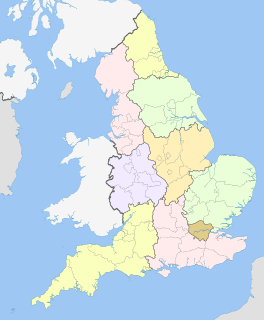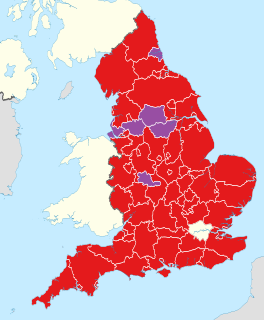Related Research Articles

The East Midlands is one of nine official regions of England at the first level of ITL for statistical purposes. It comprises the eastern half of the area traditionally known as the Midlands. It consists of Leicestershire, Derbyshire, Lincolnshire, Northamptonshire, Nottinghamshire and Rutland. The region has an area of 15,627 km2 (6,034 sq mi), with a population over 4.5 million in 2011. The most populous settlements in the region are Derby, Leicester, Lincoln, Mansfield, Northampton and Nottingham. Other notable settlements include Boston, Buxton, Chesterfield, Corby, Gainsborough, Glossop, Grantham, Hinckley, Kettering, Loughborough, Louth, Market Harborough, Matlock, Newark-on-Trent, Oakham, Skegness, Wellingborough and Worksop.

Nottinghamshire is a landlocked county in the East Midlands region of England, bordering South Yorkshire to the north-west, Lincolnshire to the east, Leicestershire to the south, and Derbyshire to the west. The traditional county town is Nottingham, though the county council is based at County Hall in West Bridgford in the borough of Rushcliffe, at a site facing Nottingham over the River Trent.

The metropolitan counties are a type of county-level administrative division of England. There are six metropolitan counties, which each cover large urban areas, with populations between 1 and 3 million. They were created in 1974 and are each divided into several metropolitan districts or boroughs. With the abolition of metropolitan county councils in 1986, with most of their functions being devolved to the metropolitan boroughs, making the boroughs effectively unitary authorities, metropolitan counties no longer form a part of local government in England. Any remaining functions were taken over by joint boards.

East Midlands Airport is an international airport in the East Midlands of England, close to Castle Donington in northwestern Leicestershire, between Loughborough, Derby and Nottingham ; Leicester is to the south and Lincoln north east. It serves the whole East Midlands region of Leicestershire, Nottinghamshire, Lincolnshire, Northamptonshire, Rutland and Derbyshire. The airfield was originally built as a Royal Air Force station known as RAF Castle Donington in 1943, before being redeveloped as a civilian airport in 1965.

Melton is a local government district with borough status in north-eastern Leicestershire, England. It is named after its main town, Melton Mowbray. Other settlements include Asfordby and Bottesford. At the 2011 census, it had a population of 50,376.

The regional chambers of England were a group of indirectly elected regional bodies that were created by the provisions of the Regional Development Agencies Act 1998. There were eight regional chambers, one for each of the regions of England except Greater London, which had opted for an elected mayor and assembly in 1998. All eight regional chambers had adopted the title "regional assembly" or "assembly" as part of their name, though this was not an official status in law. The chambers were abolished over a two-year period between 31 March 2008 and 31 March 2010 and some of their functions were assumed by newly established Local authority leaders' boards.

In the United Kingdom, regional development agencies (RDAs) were nine non-departmental public bodies established for the purpose of development, primarily economic, of England's Government Office regions between 1998 and 2010. There was one RDA for each of the NUTS level 1 regions of England. Similar activities were carried out in Wales by the Welsh Government Department of Economy and Transport, in Northern Ireland by the Department of Enterprise, Trade and Investment and in Scotland by Scottish Enterprise and Highlands and Islands Enterprise.

Metropolitan and non-metropolitan counties are one of the four levels of subdivisions of England used for the purposes of local government outside Greater London and the Isles of Scilly. As originally constituted, the metropolitan and non-metropolitan counties each consisted of multiple districts, had a county council and were also the counties for the purposes of Lieutenancies. Later changes in legislation during the 1980s and 1990s have resulted in counties with no county council and 'unitary authority' counties with no districts. Counties for the purposes of Lieutenancies are now defined separately, based on the metropolitan and non-metropolitan counties.
Regional spatial strategies (RSS) provided regional level planning frameworks for the regions of England outside London. They were introduced in 2004. Their revocation was announced by the new Conservative/Liberal Democrat government on 6 July 2010.
The regional arts boards were English regional subdivisions of the Arts Council of Great Britain
The Greater Nottingham Partnership (GNP) was formed in 1994 by Nottingham City Council and Nottinghamshire County Council with the aim of improving partnership working across the Greater Nottingham conurbation and attracting more government regeneration funding into the area.

The East Midlands Regional Assembly was the regional chamber for the East Midlands region of the England. It was based at Melton.
The West Midlands Regional Assembly (WMRA) was the regional chamber for the West Midlands region of England, established in 1999. It was based in Birmingham. It was abolished on 31 March 2010, its functions transferring to West Midlands Leaders Board and to Advantage West Midlands.

The South West of England Regional Development Agency (SWRDA) was one of the nine Regional Development Agencies set up by the United Kingdom government in 1999. Its purpose was to lead the development of a sustainable economy in South West England, investing to unlock the region's business potential. It was abolished along with all the other RDAs on 31 March 2012, with some of its functions being replaced by local enterprise partnerships.

BBC East Midlands is the BBC English Region covering Derbyshire, Leicestershire, Nottinghamshire, Rutland, southern parts of South Kesteven in Lincolnshire and some northern parts of Northamptonshire.

Local authority leaders' boards are voluntary regional associations of council leaders that have been established in England outside of Greater London to replace certain functions of the now abolished regional chambers. The establishment of the boards was part of the UK Government's Review of Sub-National Economic Development and Regeneration. which brought forward the Government's plans to alter the structure of regional governance in England and was mandated by the Local Democracy, Economic Development and Construction Act 2009. In June 2010, the new Conservative-LibDem coalition government announced plans to remove funding from the new boards and to remove their statutory functions. It was indicated that the boards might continue as voluntary associations of council leaders.

The regions, formerly known as the government office regions, are the highest tier of sub-national division in England, established in 1994. Between 1994 and 2011, nine regions had officially devolved functions within government. While they no longer fulfil this role, they continue to be used for statistical and some administrative purposes. While the UK was a member of the European Union, they defined areas (constituencies) for the purposes of elections to the European Parliament. Eurostat also used them to demarcate first level Nomenclature of Territorial Units for Statistics (NUTS) regions within the European Union, which in 2021 were superseded by International Territorial Level (ITL) regions. The regions generally follow the boundaries of the former standard regions, established in the 1940s for statistical purposes.

A combined authority is a type of local government institution introduced in England outside Greater London by the Local Democracy, Economic Development and Construction Act 2009. Combined authorities are created voluntarily and allow a group of local authorities to pool appropriate responsibility and receive certain delegated functions from central government in order to deliver transport and economic policy more effectively over a wider area.
In England, local enterprise partnerships (LEPs) are voluntary partnerships between local authorities and businesses, set up in 2011 by the Department for Business, Innovation and Skills to help determine local economic priorities and lead economic growth and job creation within the local area. They carry out some of the functions previously carried out by the regional development agencies which were abolished in March 2012. In certain areas, funding is received from the UK government via growth deals.

BioCity Nottingham is a bioscience science park in central Nottingham in the United Kingdom. It is the UK's largest bioscience innovation and incubation centre.
References
- ↑ "House of Commons - East Midlands Development Agency and the Regional Economic Strategy - East Midlands Regional". Publications.parliament.uk. Retrieved 28 October 2014.